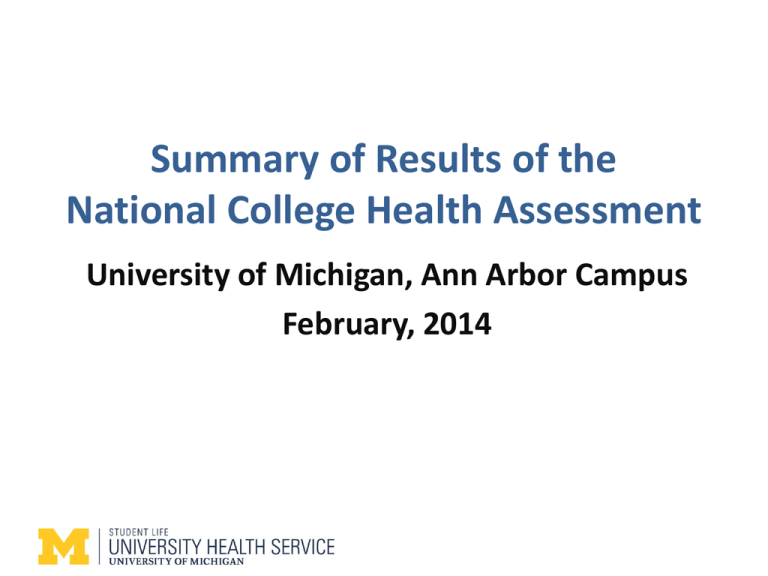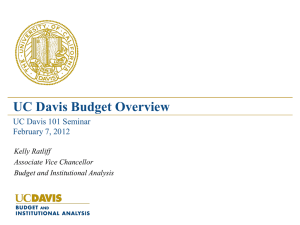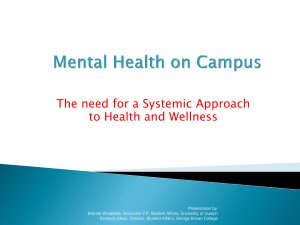
Summary of Results of the
National College Health Assessment
University of Michigan, Ann Arbor Campus
February, 2014
What is the NCHA Survey
• Designed by the American College Health Association
(ACHA) to align with Healthy Campus goals
• Measures prevalence of health risk and protective
behavior among college students
• UM previously conducted it in 1998 (pilot), 2006
(NCHA I) and 2010 (NCHA II: revised questionnaire)–
Undergraduates only
• National data compiled by ACHA (comparability
issues: sampling, college types, seasonal variations,
weighting)
2014 National College Health Assessment, #2
How Can the Data be Used?
• To provide a “snapshot” in time of the behaviors,
attitudes and beliefs of students with regard to
health
• To compare with findings from other surveys and
(especially) prior years at UM
• To develop goals to improve health outcomes and
assess progress, evaluate impact
2014 National College Health Assessment, #3
Methodology
• Conducted in February 2014 (same as in 2010)
• Random sample of 7,000 undergraduates and 5,000
graduate/professional students
• Males and undergrad minority students oversampled because of lower response rates (as in
2010)
• Email invitation with two reminder emails
• Incentives offered for participation
2014 National College Health Assessment, #4
Response Rate & Analysis
• 3,351 respondents (59 excluded as too incomplete)
• Working data file: 3,292 (1,561 undergrads, 1,731 grad/prof)
• Response rate: 28% overall, 22% among undergrads, 35%
among grad/prof
• Margin of sampling error: + 1.8% overall, + 2.9% undergrads,
+ 2.2% grad/prof
• Data weighted by gender, race, student status, and citizenship
to match UM Winter 2014 enrollment
• Analyses conducted on the weighted data
2014 National College Health Assessment, #5
Respondent Profiles
2014 National College Health Assessment, #6
Respondent Profiles
2014 National College Health Assessment, #7
Perceived Health Status
2010: 93% of Undergrads rated their health as good, very good or excellent vs. 92% in 2014
Males, white (non-Hisp), those with higher GPA rated health better
2014 National College Health Assessment, #8
Impediments to
Academic
Performance: All
Respondents
2014 National College Health Assessment, #9
Top Reported Impediments to
Academic Performance
Undergraduates (UG) [vs. 2010]
•
•
•
•
•
•
•
•
•
•
Grad/Professional (G/P)
Stress (31%) [25%]
•
Anxiety (22%) [17%]
•
Sleep difficulties (20%) [19%]
•
Extra-curricular activities (16%) [13%]•
Cold/flu/sore throat (15%) [18%]
•
Depression (15%) [10%]
•
Internet/games (15%) [14%]
•
Work (12%)
•
Relationship difficulty (9%)
•
Concern for troubled friend (8%)
•
Stress (18%)
Anxiety (14%)
Sleep difficulties (11%)
Depression (10%)
Internet/games (8%)
Work (8%)
Cold/flu/sore throat (7%)
Concern for troubled friend (7%)
Relationship difficulty (6%)
Extra-curricular activities (5%)
2014 National College Health Assessment, #10
Protective Health Behaviors
Past 30-day behaviors:
• 33% of G/P, 26% of UG [vs. 31% in 2010] females reported Breast Self Exam
• 29% of G/P, 33% of UG [vs. 31% in 2010] male respondents reported Testicular
Self Exam;
– Whites, those with lower GPAs more likely to perform TSE
Past 12-month behaviors:
• 62% of G/P, 44% of UG [vs. 48% in 2010] females reported a routine
gynecological exam;
– Whites, more likely to have had a gynecological exam
• 70% of G/P, 83% of UG [vs. 84% in 2010] reported a dental
exam/cleaning
2014 National College Health Assessment, #11
Protective Health Behaviors
• 59% of G/P, 54% of UG [vs. 46% in 2010] reported using
sunscreen regularly
– More likely among those with higher grades, female
• 91% of G/P, 81% of UG [81% in 2010] report “always” using a
seatbelt
• 57% of G/P, 28% [30% in 2010] of UG bike riders wear a
helmet “most of the time” or “always”
– Healthy Campus 2020 goal is 37.7%
• 86% of G/P, 78% of UG motorcycle riders wear a helmet “most
of the time” or “always”
– Healthy Campus 2020 goal is 94.4%
2014 National College Health Assessment, #12
IMMUNIZATION
Have you received the following
vaccinations (shots)?
Hepatitis B
Measles, Mumps & Rubella
Meningitis
HPV (women only)
Influenza (past year)
Varicella (chicken pox)
HPV (men only)
UM
Grad/Prof
2014
73%
78%
60%
53%
50%
43%
15%
UM
Undergrad
2014
67%
68%
62%
63%
48%
59%
32%
UM
Undergrad
2010
70%
68%
62%
48%
41%
38%
11%
UM
Undergrad
2006
70%
80%
70%
NA
23%
44%
NA
2014 National College Health Assessment, #13
Perception of Safety
Percent of respondents who feel “very safe:”
• 92% of G/P; 93% of UG on-campus during the day
– [vs.92% in 2010]
• 34% of G/P; 40% of UG on-campus at night
– [vs. 32% in 2010]
– 2020 Healthy Campus goal is 35.1%
• 69% of G/P; 75% of UG in Ann Arbor during the day
– [vs. 66% in 2010]
• 21% of G/P; 28% of UG in Ann Arbor at night
– [vs. 20% in 2010]
2014 National College Health Assessment, #14
Abuse and Violence
UM
G/P
2014
10%
5%
2%
2%
1%
2%
UM
UG
2014
15%
6%
6%
7%
3%
3%
Within the last 12 months were you:
Verbally threatened*
In emotionally abusive relationship
In a physical fight*
Sexually touched against will*
Physically assaulted (non-sexually)*
Victim of stalking
Attempted sexual penetration against
will*
0.7% 3.0%
In physically abusive relationship
0.8% 0.9%
Sexually penetrated against will*
0.4% 1.6%
In sexually abusive relationship*
0.5% 1.6%
* Significant at p<.05 UM G/P 2014 vs. UM UG 2014
UM
2010
21%
5%
7%
5%
4%
3%
UM
2006
NA
9%
7%
9%
4%
NA
2%
0.8%
0.6%
0.6%
3%
0.7%
2.0%
0.5%
Healthy
Campus
2020
Goals
9.0%
5.4%
4.2%
2.3%
1.4%
1.4%
2014 National College Health Assessment, #15
Non-Physical Victimization
17% of UG, 11% of G/P respondents reported nonphysical victimization (being verbally threatened or
stalked) in the last 12 months [vs. 22% in 2010]
Victimization more likely among
–Those with lower GPA
–Those in a fraternity/sorority
–Males than females
–Those who used alcohol during the previous 30 days
2014 National College Health Assessment, #16
Past 30-Day Substance Use &
Perception
% Used at least 1 day in past month
UM
UM
G/P
UG
UM
2014* 2014 2010
Alcohol
77%
70%
69%
Cigarettes
8%
10%
12%
Hookah
3%
9%
10%
Cigars
3%
6%
6%
Smokeless tobacco
2%
5%
3%
Marijuana
9%
21%
20%
Cocaine
0%
3%
1%
Amphetamines
1%
3%
2%
Ecstasy
1%
2%
0%
* All Significant at p<.05 UM G/P vs. UM UG 2014
UM
2006
73%
16%
NA
7%
2%
18%
1%
3%
0%
Healthy
Campus
2020
Goals
NA
14.4%
7.4%
NA
3.5%
15%
NA
NA
NA
Perceived “typical”
student uses 1+
days/month
UM
G/P
2014
94%
60%
49%
41%
37%
69%
20%
23%
27%
UM
UG
2014
96%
66%
63%
49%
44%
87%
28%
27%
30%
UM
2010
96%
77%
69%
59%
46%
82%
30%
31%
27%
% who perceived
"typical" student use
greater than their own
UM
G/P
2014
67%
73%
65%
62%
58%
77%
42%
44%
46%
UM
UG
2014
70%
77%
75%
69%
66%
82%
49%
45%
52%
UM
2010
73%
82%
78%
76%
68%
82%
51%
42%
52%
2014 National College Health Assessment, #17
Past 30-Day Substance Use
• Alcohol use more likely among:
– “A or B” students, grad students, white, females,
domestic students, live in fraternity/sorority house or
off campus
• Cigarette use more likely among:
– Undergrads, White, lower grades, live in
fraternity/sorority house or off campus
• Marijuana use more likely among:
– Undergrads, males, lower grades, live in
fraternity/sorority house or off campus
2014 National College Health Assessment, #18
Blood Alcohol Content
(Last Time Partied/Socialized, Drinkers Only)
2014 National College Health Assessment, #19
Use of Protective Strategies**
During the last 12 months, when you “partied or
socialized” how often did you (drinkers only):
Stay with same group of friends while drinking
Eat before/during drinking*
Use a designated driver
Keep track of how many drinks you had*
Stick with only one kind of alcohol*
Choose not to drink alcohol
Determine, in advance, not to exceed a set # of drinks *
Alternate non-alcoholic beverages*
Avoid drinking games*
Have a friend let you know when you had enough*
Pace drinks to 1 or less per hour
* Significant at p<.05 UM G/P vs. UM UG 2014
UM
G/P
2014
96%
97%
88%
84%
86%
61%
64%
69%
73%
39%
68%
UM
UG
2014
95%
96%
89%
79%
77%
57%
56%
60%
55%
51%
45%
UM
2010
95%
94%
87%
80%
75%
60%
54%
54%
53%
47%
43%
** Report doing ‘always’, ‘most of the time’, or ‘sometimes’
2014 National College Health Assessment, #20
Undesirable Consequences of
Drinking
In past year, % of drinkers who
UM
experienced consequences as a result
G/P
of their drinking:
2014
Injured yourself*
7%
Did something you later regretted*
29%
Forgot where you were, what you did*
21%
Had unprotected sex*
14%
Got in trouble with the police*
0.8%
Injured another person
0.7%
Had sex without giving consent*
0.5%
Had sex without getting consent
0.2%
* Significant at p<.05 2014 G/P vs. 2014 UG
UM
UG
2014
17%
43%
39%
18%
4%
2%
2%
0.4%
UM
2010
20%
42%
38%
10%
3%
3%
1%
0.1%
UM
2006
25%
42%
39%
11%
NA
5%
NA
NA
Healthy
Campus
2010
Goal
2.50%
No goal
2014 National College Health Assessment, #21
Prevalence of at Least One Undesirable Consequence of
Drinking by Number of Drinks at Last Time Partied
Number of. . .
Undergrads
Grad/Prof
0
537
216
1
134
157
2
206
202
3
234
176
4
215
123
5
228
77
6
160
64
Number Drinks
7
8
9
95
115
28
22
26
5
10
88
26
11
7
0
12
47
7
13
7
1
14
10
2
15
14
3
16
10
5
2014 National College Health Assessment, #22
Binge Drinking
Over the Past 2 Weeks, At Least One
Occasion Drank. . .
UM
G/P
2014
UM
UG
2014
UM
Student
Life
UM Survey
2010
2009
5+ Drinks*
28%
41%
41%
4+ Drinks (if Female), 5+ Drinks (if
Male)*
33%
* Significant at p<.05 UM G/P vs. UM UG 2014
45%
Healthy
Campus
UM
2020
2006
Goal
45%
31.6%
46%
2014 National College Health Assessment, #23
Binge Drinking in Last 2 Weeks
Positively correlated with:
• Number of sexual partners
• Number of types of physical victimization
• Prescription drug misuse
2014 National College Health Assessment, #24
Undesirable Consequences of Drinking:
Undergrads, Fraternity/Sorority Members
vs. Non-Members
2014 National College Health Assessment, #25
Use of Protective Strategies:**
Undergrads, Fraternity/Sorority Members vs.
Non-Members
** Report doing ‘always’, ‘most of the time’, or ‘sometimes’
2014 National College Health Assessment, #26
Prescription Drug Misuse
UM
G/P
2014
4%
4%
3%
UM
UG
2014
10%
5%
5%
UM
2010
9%
6%
3%
Antidepressants
3%
2%
2%
Erectile dysfunction drugs
1%
1%
0.6%
1 or more of the above*
9%
14%
Percent taking prescription drugs not
prescribed to them in the last 12 months:
Stimulants (Ritalin, Adderall)*
Painkillers (OxyCotin, Vicodin)*
Sedatives (Xanax, Valium)*
* Significant at p<.05 UM G/P vs. UM UG 2014
2014 National College Health Assessment, #27
Prescription Drug Misuse
Positively correlated with:
•
•
•
•
•
•
•
•
•
Increased BAC at last time partied or socialized
Difficulty getting to sleep
Number of emotional problems
Number of health problems
Number adverse outcomes from drinking
Sexually abusive relationships
Physical victimization
Non-physical victimization
Number of sexual partners
2014 National College Health Assessment, #28
Type of Sexual Activity
Oral Sex
No, never done
Not in last 30 days
Yes, in last 30 days
UM
G/P
2014
22%
28%
50%
UM
UG
2014
34%
26%
40%
Vaginal Sex
UM
2010
37%
25%
38%
UM
G/P
2014
24%
20%
56%
UM
UG
2014
42%
21%
37%
UM 2010
44%
19%
37%
Anal Sex
UM
G/P
2014
73%
23%
5%
UM
UG
2014
83%
13%
4%
UM
2010
85%
13%
2%
2014 National College Health Assessment, #29
Condom / Barrier Use
at Last Intercourse
if reporting past 30-day activity
2014 National College Health Assessment, #30
Number of Sexual Partners
73% of undergraduates [vs. 75% in 2010] reported
0 or 1 sexual partners in the past year
Number Sexual Partners in
Past 12 Months
No partners
1 partner
2 partners
3 partners
4 or more partners
Mean # of partners
UM
G/P
2014
24%
57%
8%
5%
7%
1.31
UM
UG
2014
37%
36%
10%
6%
11%
1.44
UM
2010
39%
36%
10%
6%
9%
1.34
UM
2006
36%
41%
8%
7%
9%
1.26
2014 National College Health Assessment, #31
Sexually Transmitted Infections
Within last 12 months, were you
diagnosed with:
Chlamydia
Genital Herpes
Genital Warts/HPV
Gonorrhea
Pelvic Inflammatory Disease
HIV Infection
UM
G/P
2014
0.6%
0.5%
0.8%
0.2%
0.2%
0.3%
UM
UG
2014
0.6%
0.0%
0.7%
0.2%
0.0%
0.2%
UM
2010
0.9%
0.8%
0.7%
0.5%
0.3%
0.1%
UM
2006
2%
1%
3%
0.3%
0.4%
0.5%
Healthy
Campus
2020
Goals
3.1%
NA
NA
NA
NA
NA
2014 National College Health Assessment, #32
HIV Testing
• 34% of Grad/Professional students, 15% of
undergrads [vs. 12% in 2010] reported ever being
tested for HIV
• Among undergrads, prevalence of ever being tested
greater among
–
–
–
–
–
–
–
Females
20+ year olds
Those with lower GPAs
More sexually active
Sexual minorities
More frequent users of illegal drugs
Those living in fraternity/sorority house or off campus
2014 National College Health Assessment, #33
Contraception, Emergency Contraception (used
by self or partner), and Unintentional Pregnancy
UM
UM
G/P
UG
2014 2014
83.2% 86.7%
Contraceptive use at last vaginal
intercourse
Any method
Emergency contraception
Of those who ever had sex
Of all students
UM
G/P
2014
8%
6%
UM
UG
2014
18%
10%
UM
2010
10%
Healthy
Campus
UM
2010
2010
Goal
91% 62.3%
UM
2006
11%
• 0.5% Undergrad [1% in 2010], 0.5% Grad females reported
unintentional pregnancy -- 2020 Healthy Campus Goal is 1.4%
2014 National College Health Assessment, #34
Contraceptive Methods
at last vaginal intercourse
Contraception use at last vaginal intercourse of those
who have had vaginal intercourse
Male Condom
Oral Contraceptives
Withdrawal
Fertility Awareness
Spermicide
Ring
Intrauterine Device
Depo Provera (shots)
Patch
Norplant (implants)
Female Condom
Diaphragm, Cap
Contraceptive Sponge
Sterilization
Other Method
2 or more methods
* Possible discrepancy in coding for tabulation.
UM
G/P
2014
59%
49%
20%
6%
3%
5%
15%
1%
0.3%
1.4%
0.4%
0.3%
0.1%
0.9%
0.7%
38%
UM
UG
2014
72%
67%
32%
5%
3%
3%
6%
2%
0.0%
0.6%
0.0%
0.0%
0.0%
0.0%
1.4%
58%
UM
2010
75%
59%
26%
7%
6%
5%
NA
1%
1%
0.8%
0.5%
0.5%
NA
NA
2%
99%*
2014 National College Health Assessment, #35
Physical Activity in Past 7 Days
Moderate / Intense Exercise ≥ 3 days/week
UM
G/P
2014
UM
UG
2014
UM
2010
Healthy
Campus
UM
2020
2006 Goals
59%
60%
50%
41%
53.6%
32%
34%
36%
48%
41.4%
2010 & 2014 Q: A) Moderate-intensity cardio or aerobic
exercise for at least 30 minutes, or B) Vigorous-intensity
cardio or aerobic exercise for at least 20 minutes?
2006 Q: Participate in vigorous exercise for at least 20
minutes or moderate exercise for at least 30 minutes?
Strength-Training Exercise ≥ 2 days/week
2010 & 2014 Q: 8-10 strength-training exercises for 8-12
repetitions?
2006 Q: Exercises to strengthen or tone your muscles,
such as push-ups, sit-ups, or weight lifting?
2014 National College Health Assessment, #36
Physical Activity
• 43% of G/P, 46% of UG respondents [vs. 48% in 2010]
met physical activity goals
– More likely if white
• Vigorous physical activity (3+ days per week) more
likely among:
– White respondents, higher GPA
• Strength-training exercises (2+ days per week) more
likely among:
– Respondents with higher grades, males, Live off campus
2014 National College Health Assessment, #37
Fruits and Vegetables
• 9% of G/P, 6% of UG [vs. 7% in 2010] reported eating
5 or more servings per day
– Healthy Campus 2020 goal is 6.6%
• 53% of G/P, 63% of UG [vs. 62% in 2010] reported
eating 2 or fewer servings per day
– More likely if lower grades, younger, male, international or
non-white
2014 National College Health Assessment, #38
Body Mass Index
BMI Category
Underweight (18.5 & under BMI)
“Normal” or “healthy” weight (18.524.9 BMI)
Obese or overweight (over 25.0 BMI)
Obese (30.0 BMI or greater)
UM
G/P
2014
4%
UM
UG
2014
6%
UM
2010
4%
UM
2006
5%
Healthy
Campus
2020
Goal
No goal
65%
71%
74%
69%
67.8%
31%
7%
23%
5%
22%
27%
10.4%
2014 National College Health Assessment, #39
Body Mass Index
• The prevalence of being overweight or obese was
greater among those who are:
– Male, have lower GPA’s, live off-campus, older, upper
classmen or G/P students, domestic students
• Those who were overweight or obese were more
likely to report:
– Lower general health
– Exercising, dieting to lose weight in the last 30 days
2014 National College Health Assessment, #40
Perceptions of Weight
• 14% of G/P students, 10% of UG [vs. 15% in 2010]
not overweight describe themselves as slightly
overweight or very overweight
• 23% of G/P students, 23% of UG [vs. 19% in 2010,
24% in 2006] overweight or obese describe
themselves as about the right weight or underweight
2014 National College Health Assessment, #41
Weight Intentions and Practices
Are you currently trying to do any of
the following about your weight?
Do nothing about weight
Stay the same weight
Lose weight
Gain weight
UM
G/P
2014
20%
30%
43%
7%
UM
UG
2014
22%
27%
39%
12%
UM
2010
17%
26%
45%
12%
UM
2006
19%
23%
49%
9%
Within the last 30 days, did you do
any of the following to lose weight?
Exercised
Nothing
Dieted
Vomited/took laxatives
Took diet pills
UM
G/P
2014
48%
48%
32%
1%
1%
UM
UG
2014
47%
48%
31%
2%
2%
UM
2010
52%
44%
33%
3%
1%
UM
2006
54%
41%
35%
3%
3%
2014 National College Health Assessment, #42
Mental Health Diagnosis or
Treatment in Past 12 Months
Diagnosed or Treated
Diagnosis
Anxiety
Depression
Panic Attacks
ADHD
Insomnia
OCD
Bipolar Disorder
Phobia
Substance Abuse/Addiction
Schizophrenia
UM G/P
2014
11%
9%
4%
3%
3%
1%
1%
1%
0%
0%
UM UG
2014
11%
10%
5%
4%
3%
2%
1%
0%
1%
0%
UM
2010
8%
7%
4%
3%
2%
2%
1%
1%
1%
0%
Type of Treatment (All Students)
MediPsycho- cation +
None Medication therapy therapy
2.2%
2.9%
2.3%
3.3%
1.4%
3.4%
1.6%
3.3%
1.2%
1.1%
0.7%
1.0%
0.8%
2.1%
0.1%
0.5%
0.9%
0.9%
0.2%
0.5%
0.3%
0.3%
0.4%
0.3%
0.1%
0.3%
0.1%
0.2%
0.1%
0.1%
0.2%
0.1%
0.1%
0.0%
0.3%
0.1%
0.0%
0.0%
0.1%
0.0%
• 18% of G/P, 15% of UG [vs. 16% in 2010] report lifetime diagnosis of
depression
2014 National College Health Assessment, #43
Emotional Disturbances
UM G/P
Within the last 12 months, have you…
2014
Felt overwhelmed by all you had to do*
81%
Felt exhausted (not by physical activity)*
79%
Felt very sad*
55%
Felt very lonely*
53%
Felt overwhelming anxiety*
46%
Felt things were hopeless*
36%
Felt overwhelming anger*
27%
Felt so depressed that it was difficult to
function*
29%
Seriously considered attempting suicide*
4%
Intentionally injured self
3%
Attempted suicide
0%
* Significant at p<.05 UM G/P vs. UM UG
UM UG
2014
90%
84%
66%
65%
56%
49%
36%
UM
2010
89%
83%
62%
62%
50%
50%
35%
UM
2006
94%
93%
80%
NA
NA
62%
NA
34%
7%
4%
1%
31%
7%
5%
1%
42%
11%
NA
1%
• Healthy Campus 2020 goal for attempted suicide is < 1.2%
2014 National College Health Assessment, #44
Emotionally Disturbing Events
More likely to be reported by:
• Females vs. males
• Undergrads vs. grad/professional
• Domestic (especially minorities) vs. international
• LGB vs. heterosexuals
• Alcohol users vs. non-drinkers
• Those who experienced 1+ harmful consequence of drinking
in past year
• Those who misused 1+ prescription drugs in past year
• Those who got fewer days of restful sleep per week
• Those who exercised fewer days per week
2014 National College Health Assessment, #45
Number Emotional Problems and
Self-Harm
2014 National College Health Assessment, #46
Stress
• 7% of G/P, 9% of UG [vs. 9% in 2010] reported less than
average or no stress
• 33% of G/P, 36% of UG [vs. 42% in 2010] reported average
stress
• 58% of G/P, 57% of UG [vs. 49% in 2010] reported more than
average or tremendous stress
• Greater stress more likely to be reported by:
– Females , domestic students, those with lower GPA’s, upper classmen
• Higher stress levels are significantly correlated with:
– Increased emotional disturbances, victimization, and more
traumatic/very difficult problems encountered
2014 National College Health Assessment, #47
Traumatic or Difficult Situations
Within the last 12 months, have any of the
following been traumatic or very difficult to UM G/P
handle:
2014
Academics*
Intimate relationships*
Finances
Other social relationships*
Sleep difficulties *
Career-related issues*
Family problems*
Personal appearance*
Personal health issue*
Health problem of family member or partner
Death of a family member or friend *
* Significant at p<.05 UM G/P vs. UM UG 2014
40%
24%
22%
14%
19%
34%
16%
11%
13%
12%
10%
UM UG
2014
UM
2010
53%
29%
22%
24%
22%
26%
21%
20%
15%
13%
13%
48%
29%
26%
25%
25%
23%
22%
21%
17%
15%
12%
2014 National College Health Assessment, #48
Lifetime Use of
Mental Health Services
• A Counselor/Psychologist:
– 38% of G/P, 32% of UG [vs. 27% in 2010]
• A Psychiatrist
– 15% of G/P, 12% of UG [vs. 10% in 2010]
• Other Medical Provider
– 12% of G/P, 12% of UG [vs. 8% in 2010]
• Member of Clergy
– 7% of G/P, 4% of UG [vs. 4% in 2010]
• UM Counseling or Health Center
– 19% of G/P, 18% of UG [vs. 14% in 2010]
2014 National College Health Assessment, #49
Sleep Quality
• 33% of G/P, 37% of UG did not sleep enough to feel rested on
5 or more days/week [vs. 75% in 2010*]
• 11% of G/P, 20% of UG [vs. 19% in 2010] reported that sleep
difficulties affected their academic performance
• Poor sleep quality more common among:
– Females, younger students, those with lower GPA,
minorities/internationals
• Poor sleep quality correlated with:
–
–
–
–
–
Increased instances of emotional disturbance
Victimization
Higher BAC at last time “partied or socialized”
Fewer days of vigorous exercise in the past week
Increased stress levels
* Possible discrepancy in coding
2014 National College Health Assessment, #50
Disability or Medical Conditions
18% of G/P, 18% of UG [vs. 16% in 2010] reported one or more disabilities or
medical conditions
Condition
Psychiatric condition
ADHD
Chronic Illness
Partially sighted or blind
Other disability
Deaf or hard of hearing
Learning disability
Speech or language disorder
Mobility or dexterity disability
UM G/P
2014
6%
5%
5%
1%
1%
1.4%
2%
0.8%
0.9%
UM UG
2014
7%
5%
4%
2%
1%
0.7%
2%
0.7%
0.6%
UM
2010
4%
4%
4%
2%
2%
2%
1%
0.7%
0.6%
2014 National College Health Assessment, #51
Received Information from UM
Ever Received Information
Topic:
Suicide Prevention
Violence Prevention
Pregnancy Prevention
STI Prevention
Alcohol and Other Drug Use
Injury and Violence Prevention
Tobacco Use
Nutrition
Physical Activity
Cold/Flu/Sore Throat
Sexual Assault/Relationship Violence Prevention
Depression/Anxiety
Stress Reduction
Eating Disorders
How to Help Others in Distress
Grief and Loss
Relationship Difficulties
Problem Use of Internet/Computer Games
Sleep Difficulties
UM
G/P
2014
30%
27%
21%
36%
50%
22%
27%
38%
58%
61%
59%
67%
60%
23%
23%
22%
24%
12%
19%
UM
UG
2014
38%
43%
48%
63%
91%
27%
30%
55%
60%
67%
85%
73%
65%
37%
37%
27%
49%
12%
19%
UM
2010
32%
42%
48%
68%
89%
26%
30%
65%
62%
84%
84%
73%
67%
40%
36%
31%
27%
23%
21%
UM
2006
30%
23%
42%
55%
19%
32%
30%
58%
Interested In Receiving
Information
UM
G/P
2014
31%
29%
25%
34%
22%
34%
18%
56%
54%
42%
36%
50%
61%
26%
53%
32%
36%
23%
50%
UM
UG
2014
38%
33%
29%
39%
26%
31%
17%
57%
52%
38%
38%
51%
65%
26%
54%
34%
33%
19%
55%
Healthy
Campus
UM
2020
2010
Goal
31%
33.1%
32%
39.6%
31%
45.1%
42%
57.4%
28%
71.3%
32%
31.7%
19%
38.6%
61%
57.6%
56%
62.6%
47%
-38%
-47%
-63%
-25%
-54%
-36%
-36%
-23%
-54%
--
= Met/Exceeded Goal
= Have Not Met Goal
= No "Healthy Campus Goal Established
2014 National College Health Assessment, #52
Received Information from UM:
All Students
Topic:
Suicide Prevention
Violence Prevention
Pregnancy Prevention
STI Prevention
Alcohol and Other Drug Use
Injury and Violence Prevention
Tobacco Use
Nutrition
Physical Activity
Cold/Flu/Sore Throat
Sexual Assault/Relationship Violence Prevention
Depression/Anxiety
Stress Reduction
Eating Disorders
How to Help Others in Distress
Grief and Loss
Relationship Difficulties
Problem Use of Internet/Computer Games
Sleep Difficulties
Healthy
Campus 2020 UM 2014:
Goal
All Students
33.1%
35.5%
39.6%
37.0%
45.1%
38.4%
57.4%
53.8%
71.3%
77.0%
31.7%
25.2%
38.6%
29.0%
57.6%
49.0%
62.6%
59.4%
-64.8%
-75.8%
-70.6%
-63.3%
-32.2%
-32.0%
-25.7%
-39.9%
-12.0%
-18.5%
= Met/Exceeded Goal
= Have Not Met Goal
= No "Healthy Campus Goal Established
2014 National College Health Assessment, #53
Healthy Campus 2020 SummaryUM met goals (undergraduates) for:
• Information received by students from UM re:
– alcohol & other drugs, STI prevention, pregnancy prevention, violence
prevention, suicide prevention
• Prevalence of academic impairment from:
– sleep difficulties, cold/flu/sore throat, work, eating disorders
• Prevalence of:
–
–
–
–
–
–
–
abusive relationship, physical assault, physically abusive relationship,
cigarette smoking, smokeless tobacco use,
chlamydia,
contraception use, unintended pregnancy
moderate exercise, normal weight, obesity,
attempted suicide
feel very safe on campus at night
2014 National College Health Assessment, #54
Healthy Campus 2020 SummaryUM 2014 did not meet goals (undergraduates) for:
• Information received by students from UM re:
– nutrition, physical activity, tobacco use, injury & violence prevention
• Prevalence of academic impairment from:
– stress, anxiety
• Prevalence of:
– sexually touched against will, sexually penetrated w/out consent,
sexually abusive relationship,
– smoking from hookah, marijuana use,
– injured self drinking, binge drinking,
– fruits & vegetable consumption,
– strength training
– bicyclists, motorcyclists wearing helmets
2014 National College Health Assessment, #55
For more information:
www.uhs.umich.edu/ncha
ContactUHS@umich.edu
University Health Service
University of Michigan
2014 National College Health Assessment, #56









